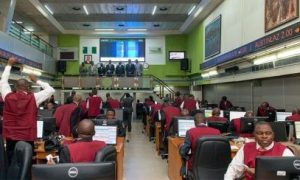Global Economy
In line with market expectations, the Federal Open Market Committee (FOMC), at the recently concluded May policy meeting, voted to keep the target range for the federal funds rate steady at 5.25% – 5.50%. A key highlight of the meeting was the Fed’s decision to start reducing the monthly redemption cap on Treasury securities holdings by USD25.00 billion (Previously: USD60.00 billion) effective from June 2024. That said, the FOMC noted that in determining the appropriate stance of future monetary policy, it will continue to monitor the implications of incoming information for the economic outlook.
The underlying tone of the FOMC suggests that the interest rate will be staying higher for longer due to the persistent price pressures and resilient labour market conditions. As a result, we anticipate the Fed will keep rates unchanged in the near term, allowing for a clearer assessment of the economy’s performance and trajectory. Thus, the CME FedWatch tool now indicates probabilities of 85.8% and 64.5% for “Hold” stances at the June and July policy meetings and a 61.3% chance of a rate cut in September.
In the Euro area, consumer prices held steady in April, emphasizing the slowdown in inflationary pressures in the zone. According to the recently released data from Eurostat, the Eurozone’s headline inflation steadied at 2.4% y/y in April (March: 2.4% y/y). Analyzing the data, we highlight a slowdown in non-energy industrial goods (+0.9% y/y vs March: +1.1% y/y), rise in food, alcohol & tobacco (+2.8% y/y vs March: +2.6% y/y) prices, and a softer decline in energy costs (-0.6% y/y vs March: -1.8% y/y). On a month-on-month basis, consumer prices slowed by 0.6% (March: +0.8% m/m).
We anticipate consumer prices to trend downwards in the coming months given that energy prices remain low. Barring any surprise change in wages or price trends, we anticipate the European Central Bank (ECB) will embark on policy easing in the near term. Accordingly, the money market pricing indicates a c. 70.0% probability of a rate cut in the June 6 monetary policy meeting.
Global Equities
The major themes in the global equities market this week have centered around (1) quarterly corporate reports, (2) US Federal Reserve’s latest monetary policy decision that initially signaled a potentially dovish pivot, and (3) US Non-farm payrolls data indicating a slowdown, which raised expectations for potential interest rate cuts by the Federal Reserve. As of the time of writing, US equities (DJIA: 0.0%; S&P 500: -0.7%) were headed for a weekly loss following the Federal Reserve’s FOMC decision to maintain the target range for the Fed funds rate. European equities (STOXX Europe: -0.6%; FTSE 100: +0.8%) posted mixed performances, as investors digested mixed corporate results and weaker-than-expected rise in US private payrolls. In Asia (Nikkei 225: +0.8%; SSE: +0.5%), sentiments remained upbeat driven by dovish remarks from the US Federal Reserve and pledges from China’s policymakers to stimulate economic growth. The Emerging Markets Index (MSCI EM: +1.1%) closed higher buoyed by positive sentiment in China (+0.5%) while the Frontier Markets index (MSCI FM: -0.1%) declined due to bearish sentiments in Iceland (-0.3%) and Kuwait (-0.2%).
Nigeria: Domestic Economy
According to the Domestic and Foreign Portfolio Report of the Nigerian Exchange (NGX), total transactions in the domestic equities market increased by 50.5% m/m to NGN538.54 billion in March (February: NGN292.07 billion). We attribute the improvement to the broad-based expansion across domestic (82.5% of market transactions) and foreign (17.5% of market transactions) inflows. On the one hand, domestic transactions rose by 52.1% m/m to NGN444.28 billion (February: NGN292.07 billion), underpinned by m/m growth across institutional and retail transactions of 69.8 % m/m and 37.9%, respectively.
On the other hand, foreign transactions increased by 43.2% m/m to NGN94.26 billion (February: NGN65.81 billion) as foreign investors continued to increase exposures in the local bourse. As a result, total domestic equities market transactions averaged NGN515.98 billion in Q1-24 (Q4-23: NGN288.50 billion | Q1-23: NGN176.74 billion). While we expect domestic investors to continue to dominate market performance, we think buying activities will be constrained by expectations regarding an uptick in yields in the FI market. On the other hand, we believe that external risk due to uncertainties around the heightened geopolitical tensions and foreign investor concerns about CBN’s weak FX reserves amid the weak macroeconomic picture would limit foreign participation in the short term.
Based on the data obtained from FMDQ, total inflows into the Nigerian Autonomous Foreign Exchange Market (NAFEM) declined by 48.1% m/m to USD1.95 billion in April (March: USD3.75 billion). The breakdown provided showed a broad-based decline across the local (75.4% of total inflows) and foreign sources (24.6%). Expressly, local inflows declined by 33.6% m/m to USD1.47 billion (March: USD2.21 billion) due to weaker inflows from non-bank corporates (-47.4% m/m), CBN (-35.1% m/m), and Exporters (-19.1% m/m) amid substantial increases in Individuals’ inflows (+96.8% m/m). Similarly, inflows from foreign sources came in lower, declining by 68.9% m/m to USD478.10 million (February: USD1.54 billion) as foreign investors began selling off risk assets to find safe havens amidst the lingering FX issues and weak macroeconomic environment. Looking ahead, we expect FX liquidity conditions to remain frail in the near term due to persistent demand-supply imbalances exacerbating distortions in the FX market. In addition, we think the elevated global interest rates and geopolitical tensions may keep foreign inflows subdued in the near term.
Capital Markets: Equities
Although the local bourse kicked off the week sluggishly, positive sentiments resurfaced later in the week, following renewed interest in banking stocks. Particularly investors’ interest in FBNH (+32.7%), GTCO (+16.1%), UBA (+12.1%) and MTNN (+6.4%) drove the benchmark index higher by 1.5% w/w to 99,587.25 points, with the Month-to-Date and Year-to-Date returns settling at +1.4% and +33.2%, respectively. However, trading activity was mixed, as the total trading volume increased by 5.6% while the total trading value declined by 4.7% w/w. Analysing by sectors, the Banking (+9.4%) and Insurance (+1.0%) indices advanced while the Oil and Gas (-0.7%), Industrial Goods (-0.4%) and Consumer Goods (-0.3%) indices declined.
Looking ahead, we expect investors to adjust their portfolios based on assessment of Q1-24 corporate earnings reports. However, the prospect of higher fixed income yields could dampen buying interests, especially in the absence of any significant positive catalysts.
Money market and fixed income
The overnight (OVN) rate contracted by 417bps w/w to 27.1%, following the inflows from FGN bond coupon payments (NGN53.35 billion) and OMO maturities (NGN42.00 billion). The average system liquidity remained positive, closing at a net long position of NGN706.61 billion (vs. a net long position of NGN1.07 trillion from the previous week).
Barring any significant liquidity influx into the financial system next week, we envisage the OVN rate will likely notch higher amid possible debits for net NTB issuances at Wednesday’s auction.
Treasury bills
Proceedings in the Treasury bills secondary market closed on a bullish note driven by bargain hunting mainly at the short end of the curve amid pressures on longer-dated papers. As a result, the average yield across all instruments declined by 7bps to 21.3%. Across the market segments, the average yield at the T-bills segment dipped by 2bps to 22.3% but contracted by 7bps to 18.7% in the OMO segment.
Following our expectation of a likely liquidity deficit next week, we anticipate a northward movement in yields in the Treasury bills secondary market as demand for instruments moderate. In addition, the CBN is scheduled to hold an NTB PMA on Wednesday (08 May) with NGN179.36 billion worth of maturities on offer.
Bonds
Trading in the Treasury bonds secondary market was bullish, as the average yield declined by 12bps to 18.8%. Across the benchmark curve, the average yield contracted at the short (-15bps), mid (-25bps) and long (+3bps) segment following interests in the APR-2029 (+35bps), APR-2032 (-40bps) and APR-2037 (-40bps) bonds, respectively.
We expect players in the Treasury bonds secondary market to continue to reshuffle their holdings in preparation for this month’s FGN bond auction scheduled to hold on 13 May and thus, anticipate activities will remain subdued in the meantime. Over the medium term, we expect yields to remain elevated, driven by the (1) anticipated monetary policy administration globally and domestically and (2) sustained imbalance in the demand and supply dynamics.
Foreign Exchange
Nigeria’s FX reserves settled higher this week as the gross reserves level grew by USD132.68 million to USD32.28 billion (02 May). Meanwhile, the naira depreciated further by 4.4% to NGN1,400.40/USD at the Nigerian Autonomous Foreign Exchange Market (NAFEM). We highlight that the CBN sold c. USD42.00 million to banks this week in the range of NGN1,200.00 – NGN1,220.00. At the NAFEM, total turnover (as of 02 May) decreased by 34.1% WTD to USD871.20 million, as trades were consummated within the NGN1,060.00 – NGN1,451.00/USD limit. In the Forwards market, the naira rates recorded on the 1-month (-4.1% to NGN1,409.48/USD), 3-month (-3.7% to NGN1,447.73/USD), 6-month (-3.4% to NGN1,495.35/USD) and 1-year (-3.1% to NGN1,628.44/USD) contracts decreased.
The naira remained volatile in the FX market, largely reflecting weak capital inflows and subpar interventions from the CBN. Although concerns about the escalation of the Middle East conflict are waning, we highlight that the moderation of yields on naira-denominated assets amid elevated global interest rates are further discouraging FPI inflows. With the CBN maintaining a relaxed stance on its monetary tightening measures and considering the persisting uncertain geopolitical environment, we anticipate FPI inflows will remain subdued. Consequently, the naira is expected to remain under pressure in the short term.
Cordros



























